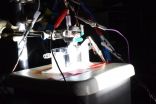Seismic signature of small underground chemical blasts linked to gas released in explosion
Finding may have implications for monitoring of nuclear test detonations
2015-09-14
(Press-News.org) SAN FRANCISCO--After analyzing the seismic waves produced by small underground chemical explosions at a test site in Vermont, scientists say that some features of seismic waves could be affected by the amount of gas produced in the explosion.
This unexpected finding may have implications for how scientists use these types of chemical explosions to indirectly study the seismic signal of nuclear detonations. Researchers use chemical blasts to learn more about the specific seismic signatures produced by explosions--which differ from those produced by earthquakes--to help efforts to detect and trace nuclear test explosions under entities such as the Comprehensive Nuclear-Test-Ban Treaty.
Chemical explosions are only a proxy for nuclear explosions, however, and it is difficult to say how or if the results of the new study may apply to seismic monitoring of nuclear explosions, cautioned study author Anastasia Stroujkova of Weston Geophysical Corp.
In the study published online in the Bulletin of the Seismological Society of America, Stroujkova reports that characteristics of P waves produced by chemical explosions depend on the amount of gas by-products released in the rock cavity that is created by the blasts. P waves are the fast-moving seismic waves that push and pull through rock in the direction of the wave's propagation, and are the first part of a seismic signature to reach a seismic monitoring station.
In particular, the lingering, non-condensable gas produced in the explosions seemed to affect the size of low frequency portion of P waves, which could be important for seismic monitoring, said Stroujkova. High frequency seismic waves weaken faster than low frequency waves, sometimes becoming lost among the background noise of other seismic signals before they can reach monitoring stations a thousand or more kilometers away, "while the low frequencies can be detected and analyzed further away from the sources," she explained.
In nuclear explosions, the low frequency amplitude is also proportional to the yield, or amount of energy discharged by a detonation, Stroujkova noted, making it "an important observable characteristic of seismic waves."
The amount of gas produced in the chemical explosions could affect the low frequency P waves in two possible ways, Stroujkova suggested. The expanding gas could contribute to an increase in the volume of the rock cavity produced by the explosion, or the gas may be fracturing the surrounding rock for a long time after the initial explosion. "More research is needed to better understand and clarify these possible effects," she said.
The explosions studied by Stroujkova are part of the New England Damage Experiment (NEDE) in Vermont, conducted by Weston Geophysical Corp. in collaboration with New England Research, Inc. The main goal of the NEDE is to study seismic waves generated by explosives that differ in detonation power. In particular, the project has focused on the slower, shear or S waves, in which oscillations take place in the plane perpendicular to P waves.
The small explosions studied by Stroujkova were fueled by either an ammonium nitrate and fuel oil combination or Composition B, an explosive mix often used in artillery projectiles and land mines. The explosives were detonated in boreholes in the granite bedrock at depths ranging from about 11 to 13 meters (36 to 46 feet) deep. The explosions were performed by a team of professional blasters within a rock quarry. The explosions, designed to be fully contained underground, are smaller than the majority of the blasts used in quarry mining.
INFORMATION:
[Attachments] See images for this press release:

ELSE PRESS RELEASES FROM THIS DATE:
2015-09-14
A new guideline that aims to prevent fractures in residents of long-term care facilities is targeted at frail seniors and their families as well as health care workers. The guideline, published in CMAJ (Canadian Medical Association Journal), was developed with input from residents of long-term care facilities and their families, as well as researchers and health care professionals.
Seniors living in long-term care homes have a two- to four-fold risk of sustaining a fracture such as a hip or spinal fracture, compared with adults of similar age living in the community. ...
2015-09-14
Scientists have identified a gene - FOXC1 - that, if switched on, causes more aggressive cancer in a fifth of acute myeloid leukaemia (AML) patients, according to a Cancer Research UK study* published in the journal Cancer Cell, today.
The FOXC1 gene is normally switched on during embryonic development and is needed to turn cells into specialised tissues, like the eyes, kidney, brain and bone.
But this new research found that in certain patients with AML - a type of blood cancer that affects white blood cells and the bone marrow - this gene was wrongly switched on inside ...
2015-09-14
(BOSTON) - Stem cell therapies are often limited by low survival of transplanted stem cells and the lack of precise control over their differentiation into the terminal cell types needed to repair or replace injured tissues. Now, a team led by Wyss Institute Core Faculty member David Mooney, Ph.D., has developed a new strategy - embedding stem cells into porous, transplantable hydrogels - that has experimentally improved bone repair by boosting the survival rate of transplanted stem cells and influencing their cell differentiation.
Mooney - who is also the Robert P. Pinkas ...
2015-09-14
(Boston)--A panel of experts and researchers have developed a new classification system for gout, the most common form of inflammatory arthritis. This new system standardizes the classification of this condition using a variety of evidence-based criteria.
Led by a researchers at Boston University School of Medicine (BUSM) and institutions from around the world, the study is a joint publication appearing in two journals simultaneously, Annals of Rheumatologic Disease and Arthritis & Rheumatology.
Gout is characterized by the deposition of a specific type of crystal in ...
2015-09-14
GAINESVILLE, Fla. -- Larger and private colleges and universities seem to attract hookah cafes and lounges, but smoke-free policies decrease these odds, according to findings published in the American Journal of Preventive Medicine this month.
That may bode well for the long-term health of college-age students.
Waterpipe smoking, more commonly known as hookah, boasts enticing flavors and a healthier reputation, increasing its popularity among college students. It is estimated that more than 10 percent of U.S. college students are current users.
However, recent evidence ...
2015-09-14
MADISON, Wis. -- Hydrogen could be the ideal fuel: Whether used to make electricity in a fuel cell or burned to make heat, the only byproduct is water; there is no climate-altering carbon dioxide.
Like gasoline, hydrogen could also be used to store energy.
Hydrogen is usually produced by separating water with electrical power. And although the water supply is essentially limitless, a major roadblock to a future "hydrogen economy" is the need for platinum or other expensive noble metals in the water-splitting devices.
Noble metals resist oxidation and include many ...
2015-09-14
Societies are failing women, children and adolescents, particularly in the poorest communities around the world, and urgent action is needed to save lives and improve health, say global health experts.
In a special supplement published today by The BMJ, public health experts from around the globe highlight the critical actions and investments that will have the greatest impact on the health and well-being of women, children and adolescents.
The 15 papers in this special supplement outline the current evidence, identify successes as well as critical gaps in progress, ...
2015-09-14
Montreal, September 14, 2015 - Using extensive genetic data compiled by the UK10K project, an international team of researchers led by Dr. Brent Richards of the Lady Davis Institute at the Jewish General Hospital has identified a genetic variant near the gene EN1 as having the strongest effect on bone mineral density (BMD) and fracture identified to date. The findings are published in the forthcoming issue of the prestigious journal Nature.
"EN1 has never before been linked to osteoporosis in humans, so this opens up a brand new pathway to pursue in developing drugs to ...
2015-09-14
BLOOMINGTON, Ind. -- A study three years ago sparked a medical mystery when it revealed a part of the brain not found in any present-day anatomy textbooks.
Recently, Indiana University computational neuroscientist Franco Pestilli and an international research team published an article in the journal Cerebral Cortex that suggests this missing part of the brain may play an important role in how we understand the world -- despite getting "lost" for more than a century.
A long flat bundle of nerves called the vertical occipital fasciculus, or VOF, the structure appeared ...
2015-09-14
Researchers at Cardiff University have devised a way of increasing the yield of biodiesel by using the waste left over from its production process.
Using simple catalysis, the researchers have been able to recycle a non-desired by-product produced when biodiesel is formed from vegetable oil, and convert this into an ingredient to produce even more biodiesel.
It is believed this new process will have significant environmental benefits by improving the yield of biodiesel in a sustainable way that doesn't require the use of additional fossil fuels, and could potentially ...
LAST 30 PRESS RELEASES:
[Press-News.org] Seismic signature of small underground chemical blasts linked to gas released in explosion
Finding may have implications for monitoring of nuclear test detonations



